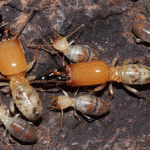
In this NASA image of the Deepwater horizon spill, the oil appears silver while the vegetation is red. Image: Jesse Allen/NASA/GSFC/METI/ERSDAC/JAROS, and U.S./Japan ASTER Science Team
Scientists have developed micro-submarines that can clean up oils spills.
Oil is a common by-product of various manufacturing processes, and has become a major source of groundwater contamination and ocean pollution. Large spills, such as the 1989 Exxon Valdez spill and the 2010 Deepwater Horizon incident, may release millions of tonnes of crude oil into the oceans.
Scientists from Spain and the US have developed and tested self-propelled micro-machines that can pick up oil droplets from water. While micro-machines have been developed for other purposes, such as the transport of drugs through the bloodstream, this is the first time they have been considered as a tool for cleaning up oil spills.
“We have presented the first example of using artificial nano or microscale machines for environmental remediation applications and specifically the tailoring of the surface of such self-propelled machines to interact strongly with oily liquids,” the researchers say in the study published in ACS Nano.
The micro-submarines are approximately eight μm long and move at an ultrafast speed (over 1400 body lengths per second). But the key to their oil-collecting activities is their superhydrophobic surface coating, which consists of self-assembled alkanethiol monolayers that interact with the oil via adhesion and permeation.
The resulting interaction between the coating and the oil caused the cone-shaped machines to collect oil droplets from contaminated water samples. The hydrophobic coating also enabled them to repel water, so they could transport their captured droplets through the sample.
“These results demonstrate the potential of the superhydrophobic-modified micro-submarines for facile, rapid and highly efficient collection of oils in oil-contaminated water samples,” the researchers say. The oil-absorbing properties of the self-propelled micro-engines could also be used for the isolation of other hydrophobic targets such as drugs.
Their tiny size doesn’t limit their capabilities, as the researchers also noted that while five droplets were collected from a contaminated sample in a 12 second navigation, the machine was able to collect 40 droplets during an 80 second navigation. However, the increased drag from the droplets slowed the machines down, suggesting that the submarines’ speeds will be dependant on how many droplet they’re carrying at a given time.
“As common for nanomotor-based cargo pickup, the optimal motor speed will provide a trade-off between sufficient contact time and large contact rate.”






